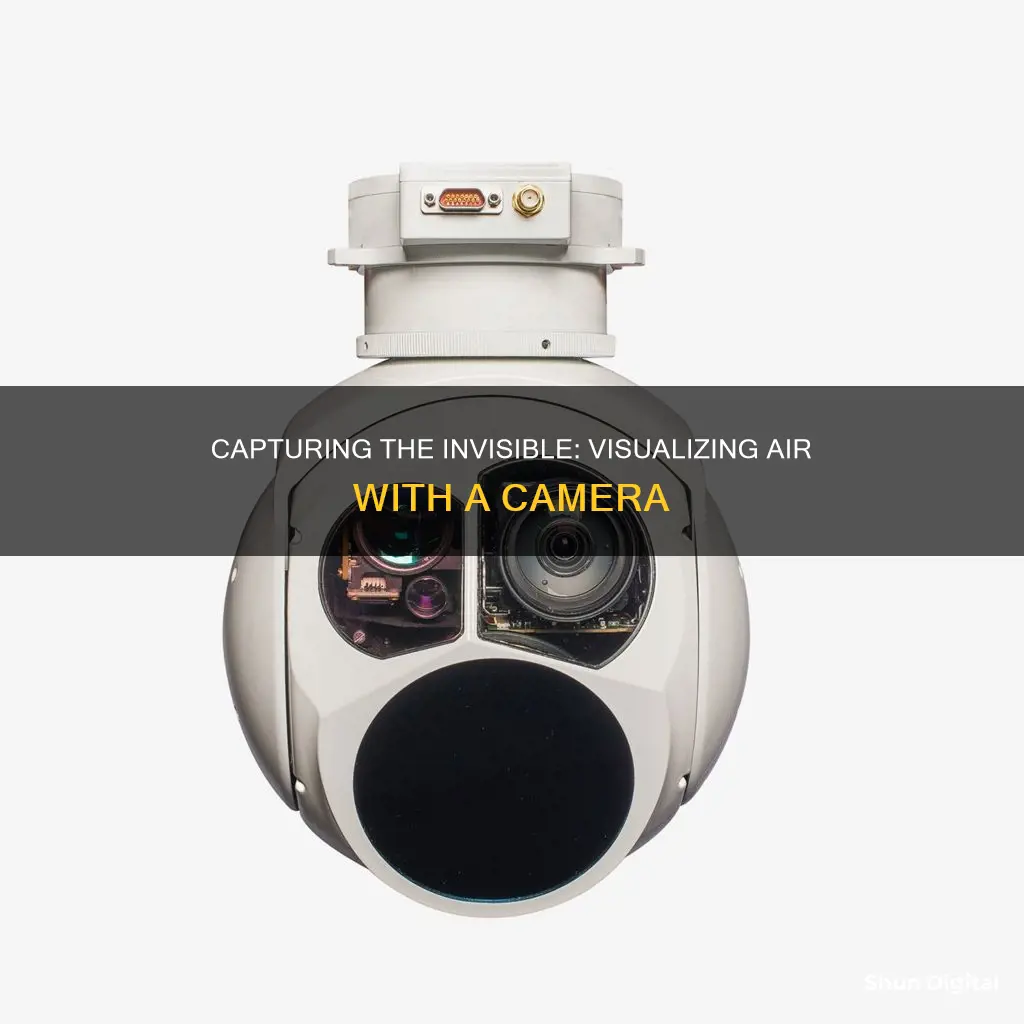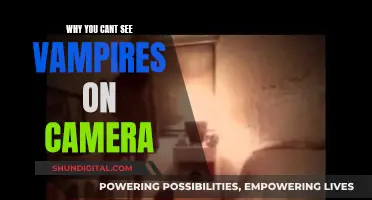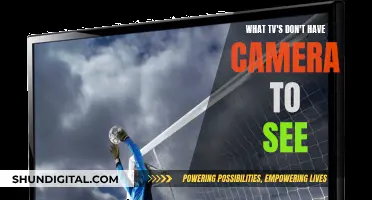
The ability to see air with the naked eye is an intriguing concept, and it is now possible through the use of Schlieren optics. Schlieren flow visualization and photography employ an optical trick that allows a camera to capture small changes in the refractive index of air, making it possible to visualize anything that influences airflow, such as heat, sound waves, or air currents. This technique has been demonstrated by scientists at Harvard Science Demonstrations, who used a concave mirror, a light source, and a razor blade to make air and other gases visible. The setup is strategically placed in front of a camera to record the fascinating phenomenon of air movement.
| Characteristics | Values |
|---|---|
| Method | Schlieren photography |
| Setup | A light source, a concave mirror, a razor blade, and an imaging device |
| Function | Captures small changes in the air's refractive index, visualising anything that affects airflow |
What You'll Learn

Using Schlieren optics
The Schlieren optics setup involves using a video camera and monitor to observe phenomena such as warm convection currents rising from a candle flame or cold air sinking from a glass of ice water. The setup typically includes a spherical mirror, light source, light block, and video camera, carefully aligned in a space that is approximately 7 meters long and 2 meters wide.
The light source is usually a small, bright, battery-powered LED flashlight with a pinhole and vellum for uniform illumination. The light block is often a razor blade or thin wire, positioned directly in front of the camera lens and acting as a light block. The spherical mirror is typically made of protected aluminum and has a diameter of 12.5" (31.8 cm) and a focal length of 123" (312 cm). The video camera used in the demonstration is a Blackmagic Pocket Cinema Camera, adapted with a Canon TV-16 25-100 mm f/1.8 Zoom Lens.
The alignment process involves levelling the optics rail, positioning the telescope mirror at a distance of two focal lengths from the razor blade, and adjusting the height of the optics rail so that the laser beam hits the mirror in the middle. The mirror is then rotated to direct the laser beam back towards the pinhole, and fine adjustments are made to ensure the beam precisely hits the pinhole.
The Schlieren effect is observed when there is a change in the refractive index of the air in the test area, causing the image of the point light source to deflect slightly. If the deflection is large enough, the additional light entering the camera appears as streaks of light, originating from the area where the refractive index changed. The brightness of the Schlieren effect is directly proportional to the magnitude of the change in refraction.
The Schlieren technique is widely used in aeronautical engineering to study the flow of air around objects and has applications in fields such as heat transfer, leak detection, and the characterisation of optics.
Where is the Camera on My Smart TV?
You may want to see also

Reflecting a light source from a concave mirror
To see air with a camera, one can use Schlieren flow visualisation and photography, an optical trick that allows a camera to capture small changes in the index of refraction in the air. This technique was demonstrated by scientists at Harvard Science Demonstrations. They assembled Schlieren optics by reflecting a light source from a concave mirror onto a razor blade. The optics are set up in front of a camera to record the process.
A concave mirror is a mirror that curves inwards. When light hits a flat or "plane mirror", it bounces off at the same angle in the opposite direction. However, if the surface of the mirror is curved, the angles of reflection are different at different points on the surface.
When a group of light rays from a distant source hit a concave mirror, they are reflected back towards a single location known as the focal point. This produces a magnifying effect, such as that seen in a makeup mirror. The radius of curvature of a mirror determines its magnification factor and its focal length.
In the Harvard experiment, a light source is reflected from a concave mirror onto a razor blade. A person or a camera looks over the razor blade at an object in front of the mirror. If the path of the light rays is perturbed and the image is shifted upwards, the light previously blocked by the razor blade reaches the eye or camera. This results in an illusion of brightness in the region that is the cause of the perturbation.
Setting Up Swann Camera System: A Step-by-Step Guide
You may want to see also

Capturing small changes in the air's refractive index
Schlieren optics can be set up by reflecting a light source from a concave mirror onto a razor blade, which is placed in front of a camera. This setup allows the camera to capture small changes in the air's refractive index, which is crucial in various applications, including astronomical observations and the design of optical systems.
The refractive index of air is influenced by temperature, humidity, and pressure, and can vary slightly depending on these factors. The refractive index of air at sea level under standard conditions is approximately 1.0003.
By using Schlieren optics, it is possible to visualise anything that affects airflow, such as heat, sound waves, or air currents. This technique provides valuable insights into the properties of air and its behaviour under different conditions.
Stream Swann Camera Footage to Your TV
You may want to see also

Visualising air currents, heat and sound waves
Visualizing Air Currents, Heat, and Sound Waves
Visualizing Air Currents
Special optics, such as Schlieren optics, can be used to visualize air currents with a camera. This technique involves reflecting a light source from a concave mirror onto a razor blade, which is set up in front of a camera. The camera can then record disturbances in the air currents, such as those created by a hairdryer or a balloon, which are normally invisible to the naked eye.
Visualizing Heat
Heat mapping is a video analytics tool offered by some high-end network camera products. It provides a graphic overlay in the form of a heat map, displaying the area and frequency of motion detected in the video captured by the camera. The heat map uses a series of colors ranging from red and orange (hot spot areas) to blue and green (low traffic areas) to indicate the areas of interest. This technology has applications beyond security and safety, such as in retail to analyze customer movement and optimize product placement.
Visualizing Sound Waves
While it is not possible to see sound waves with the naked eye, scientists have developed several approaches to visualize them for research purposes. One method is to use the Schlieren effect, which optically isolates the deviations of light rays that cross a medium due to changes in its refractive index. By coupling an optical device using the Schlieren effect to a high-frequency camera, and emitting high-frequency, high-intensity sounds, it is possible to visualize the variations in air pressure and, therefore, see the sound waves. Another approach is to use a microphone, such as the one invented by Emile Berliner in 1876, which analyzes local variations in air pressure and visualizes the evolution of sound waves over time.
Apple Watch: Camera Feature or Missing Component?
You may want to see also

Using a telescope, LED light, and a razor blade
To see air with a camera, you can use Schlieren optics, an optical trick that allows a camera to capture small changes in the refractive index of whatever's in front of the mirror. This setup involves using a concave mirror, an LED, a camera with a telephoto lens, and a razor blade. Here's a detailed guide on how to set up and use this method:
Firstly, you'll need to gather the required equipment. For the mirror, an optical-grade concave mirror is ideal, but you can also use a telescope mirror or a shaving mirror. For the light source, an LED will suffice. Any camera with a telephoto lens will work, but ensure it has a stable mount or tripod. Finally, a razor blade or any small, sharp edge can be used.
Now, let's set up the optics. Place the LED light source on a stable surface at one end of a room. Position the concave mirror on another stable surface at the opposite end of the room, facing the light source. You may need to adjust the mirror to ensure the light reflects back towards the light source. This can be done by fine-tuning the mirror's horizontal and vertical adjustment screws.
Next, set up the camera and razor blade. Position the camera with the telephoto lens attached behind the focal point of the light source. Ensure the camera is stable and can capture the mirror in the frame. Now, vertically place the razor blade near the focal point, without obscuring the light. Fine-tune the position of the razor blade until you achieve the desired effect.
Once the setup is complete, you can start experimenting! Try lighting a match or a candle in front of the mirror, and you'll see the differences in the refractive index of the air around the flame captured as lighter and darker spots by the camera. You can also try using a hairdryer or observing the effects of cold air from a glass of ice water.
This method is a fascinating way to visualize airflow and the invisible changes in the refractive index of air. With the right equipment and setup, you can capture stunning visuals that reveal the usually invisible world of air movement.
Displaying Footage: 180-Degree Camera to TV Setup
You may want to see also
Frequently asked questions
Schlieren photography is a technique that uses optical tricks to capture small changes in the air's refractive index, allowing a camera to see anything that affects airflow, such as heat or sound waves.
The Schlieren optics setup involves reflecting light from a concave mirror onto a razor blade, which is positioned in front of a camera.
You will need a concave mirror, a light source, a razor blade, and an imaging device or camera.
You can capture anything that affects airflow, including heat, sound waves, and air currents.
The Harvard Natural Sciences Lecture Demonstrations YouTube channel has a video showcasing Schlieren optics, and the Brusspup YouTube channel also has a video demonstrating the technique.







